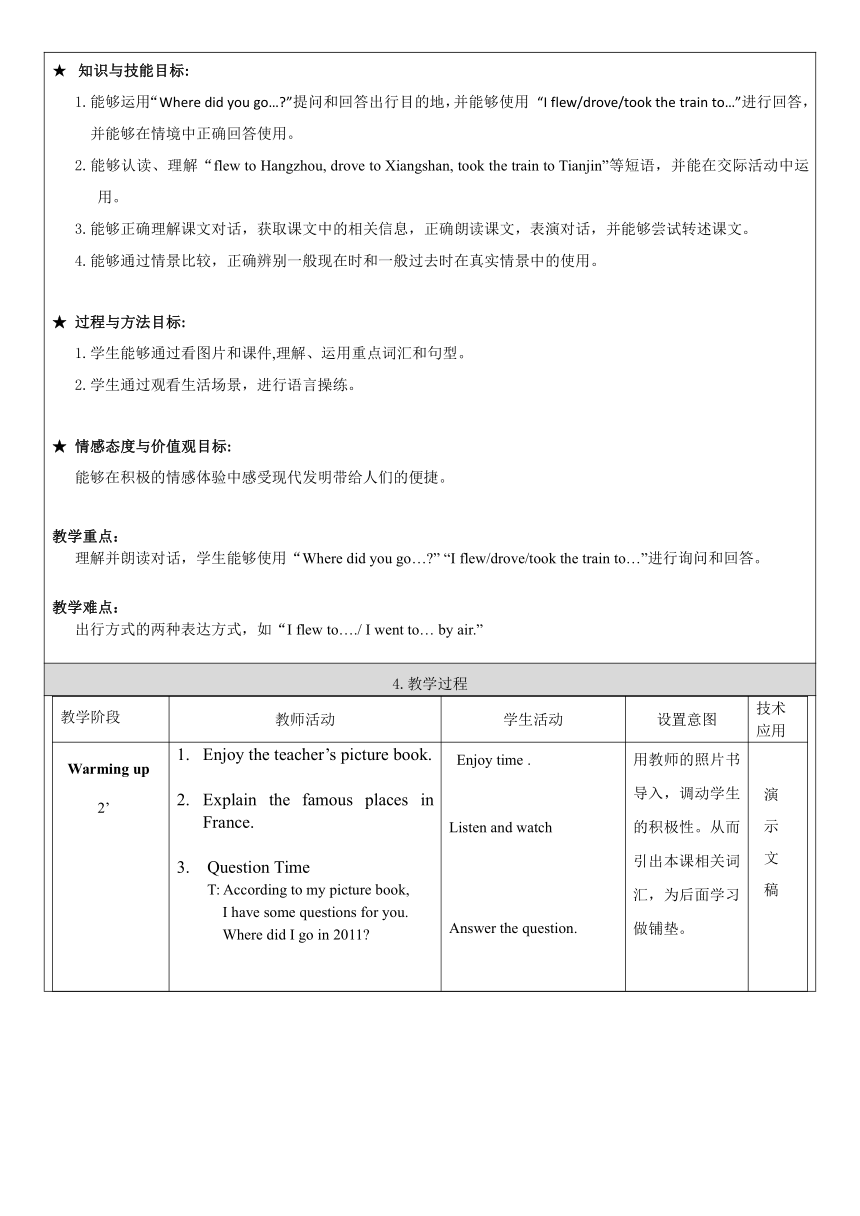Unit 3 How did you go to Hangzhou? Lesson 9 表格式教案
文档属性
| 名称 | Unit 3 How did you go to Hangzhou? Lesson 9 表格式教案 |  | |
| 格式 | zip | ||
| 文件大小 | 129.4KB | ||
| 资源类型 | 教案 | ||
| 版本资源 | 北京版 | ||
| 科目 | 英语 | ||
| 更新时间 | 2019-08-20 08:40:06 | ||
图片预览


文档简介
教学设计个人信息
姓名
单位
联系方式
设计者
教学基本信息
课题
Unit3 How did you go to Hangzhou? Lesson 9
学科
英语
学段
高年级
年级
六年级
相关
领域
教材
书名:六年级上册 出版社:北京出版社 出版日期:
1.指导思想与理论依据
小学英语课的主要目标是培养学生的综合语言运用能力。本着这一思想和理念,我在设计本课教学时从激发和保持学生的学习兴趣入手,精心创设生活化的语言情景,使学生充分感受学习英语的乐趣,培养学生具有进行语言综合实践活动的能力。
2.教学背景分析
教材分析:
本单元是在前两个单元谈论过去发生的事情或者活动的基础上,聚焦出行目的地和出行方式的话题,通过本单
元的学习,学生能够用两种不同的方式对出行方式进行表述,对他人的出行方式进行简单而力魔的询问。通过Mike
和他父母在杭州游览的经历,用过去时对杭州的名胜古迹和特产等相关内容进行介绍。学生通过这样的学习,结合
前两个单元的学习,可以基本掌握如何就过去发生的事情或经历进行交流。
★ 学生分析:
学生经过小学六年的英语学习,已经具备了一定的听说读写技能。已经学过有关将来时的提问及回答,对本课出现的词汇也有一定的储备。大部分学生都在校外参加英语学习,课外知识积累较多;学生具备一定的听说读写技能,对英语学习有兴趣,乐于参与课堂活动。
教师分析:
本人对英语教学已有十几年的教学经验。能够认真研究教材和学生的认知水平,能够根据学生的特点设计教学
内容,灵活安排各项学习活动,激发学生的学习热情,关心和爱护每一个学生,培养学生的综合语言运用能力。
3.教学目标(含重、难点)
知识与技能目标:
1.能够运用“Where did you go…?”提问和回答出行目的地,并能够使用 “I flew/drove/took the train to…”进行回答,并能够在情境中正确回答使用。
2.能够认读、理解“flew to Hangzhou, drove to Xiangshan, took the train to Tianjin”等短语,并能在交际活动中运用。
3.能够正确理解课文对话,获取课文中的相关信息,正确朗读课文,表演对话,并能够尝试转述课文。
4.能够通过情景比较,正确辨别一般现在时和一般过去时在真实情景中的使用。
★ 过程与方法目标:
1.学生能够通过看图片和课件,理解、运用重点词汇和句型。
2.学生通过观看生活场景,进行语言操练。
★ 情感态度与价值观目标:
能够在积极的情感体验中感受现代发明带给人们的便捷。
教学重点:
理解并朗读对话,学生能够使用“Where did you go…?” “I flew/drove/took the train to…”进行询问和回答。
教学难点:
出行方式的两种表达方式,如“I flew to…./ I went to… by air.”
4.教学过程
教学阶段
教师活动
学生活动
设置意图
技术
应用
Warming up
2’
Enjoy the teacher’s picture book.
Explain the famous places in France.
3. Question Time
T: According to my picture book,
I have some questions for you.
Where did I go in 2011?
Enjoy time .
Listen and watch
Answer the question.
用教师的照片书导入,调动学生的积极性。从而引出本课相关词汇,为后面学习做铺垫。
演 示
文 稿
Leading in
3’
Show the Picture.
Ask and Answer
Who’s he?
Is he happy?
Why?
Look at the picture.
Answer the questions
He’s Mike.
No.
出示主人公
Mike,
用Mike不高兴的图片引出故事。
演 示
文 稿
Presentation
23’
Watch and Listen
播放第一遍课件
T: Get the students to listen to the
dialogue for the first time.
2. Group work
T: Now, after watching the story of
Mike, Can you ask some questions?
T: Next, take out the paper.
Let’s write the questions and new
words in groups.
Share the questions.
( 1) Share questions.
How did Mike miss the flight?
Who went there with Mike?
( 2 ) Share the new words.
T: Do you have any new words?
Review the dialogue.
T: Next, let’s review the dialogue, I’ll
check your answers.
Q1:Where did Mike go?
Q2:Who went there with Mike?
Q3:Why didn’t Guoguo see Mike in school on Monday?
Explain the new words.
flight
passport
6. Watch and Listen
播放第二遍课件
7. Read by yourselves
8. Role Play
播放第三遍课件
9. Retell the story
Watch and listen.
Group work
Students write some questions on the paper.
Share the questions.
Students share the questions in the class.
S1: ……
S2: ……
Students share the new words in the class.
S1: ……
S2: ……
Answer the questions
He flew to Hangzhou.
His parents.
Because Mike’s parents and he took a trip last weekend. They missed their flight and came back late.
Watch and Listen
Listen and Repeat
Read by yourselves
Role Play
Retell the story
教师带领学生一起回顾课文,检验学生是否已经明白课文大意
Production
10’
1.Listen, Look and Learn
Ask and answer
fly-flew
drive-drove
take-took
(3) Enjoy students’ picture book
2. Listen, write and Match
(1)Listen to the dialogue for 2 times
(2)Check the answers
Ask and answer
Listen to the dialogue
Summary
1’
Today we have learned a dialogue. We can introduce our trip with these sentences.
Homework
1’
1. Listen to the dialogue and read it.
2. Interview your classmates: How does she/ he go to school?
Blackboard
5.学习效果评价设计
称赞是树立自信心的有效途径。孩子们对鼓励与称赞的需要,就如同种子需要水一样。如何让孩子在英语课堂中体验成功,拥有一份自信,很大的因素在于教师如何在评价中运用鼓励与称赞的艺术。那么在本课中,我采用了以下两种评价方法对学生进行有效的称赞:
一、语言评价
本课中,我会从声音、语言、语调等几方面对学生进行评价、鼓励、激发、调动他们积极参与课堂的兴趣,从而发挥学生在学习过程中的积极性和主动性。同时,对学生在课堂中的个性表现给予赞扬,促进其积极参与课堂活动。
二、激励性评价
为了反馈学习效果,提升教学方法的实效性,针对本课学习内容和学生特点,我设计了一下评价内容。
6.本教学设计与以往或其他教学设计相比的特点(300-500字数)
以新颖的呈现方式,提高学生实用语言的能力
在预热环节,教师用电子照片书展示自己去法国的旅行。情景是真实的,还能够吸引学生的注意力。
在句型环节,为了巩固新学的句型,以电子照片书的形式展示学生的旅程。学生也能运用现代媒体制作他们自己的电子故事书。
二、以学生提问的方式解读文本,培养学生自主学习的能力
教师改变以往的教师问、学生答的方式,变被动回答为主动提问。
同课章节目录
- Unit 1 What did you do this summer?
- Lesson 1
- Lesson 2
- Lesson 3
- Lesson 4
- Unit 2 What happened to your neck?
- Lesson 5
- Lesson 6
- Lesson 7
- Lesson 8
- Unit 3 How did you go to Hangzhou?
- Lesson 9
- Lesson 10
- Lesson 11
- Lesson 12
- Unit 4 Revision
- Lesson 13
- Lesson 14
- Unit 5 When did the ancient Olympic Games begin?
- Lesson 15
- Lesson 16
- Lesson 17
- Lesson 18
- Unit 6 What is he wearing?
- Lesson 19
- Lesson 20
- Lesson 21
- Lesson 22
- Unit 7 What are the twelve animals?
- Lesson 23
- Lesson 24
- Lesson 25
- Lesson 26
- Unit 8 Revision
- Lesson 27
- Lesson 28
